Crypturellus

Tataupa Tinamou, by Dario Sanches, CC BY-SA 2.0
Name: Crypturellus
Status: Extant
First Described: 1914
Described By: Brabourne & Chubb
Classification: Dinosauria, Theropoda, Neotheropoda, Averostra, Tetanurae, Orionides, Avetheropoda, Coelurosauria, Tyrannoraptora, Maniraptoriformes, Maniraptora, Pennaraptora, Paraves, Eumaniraptora, Averaptora, Avialae, Euavialae, Avebrevicauda, Pygostylia, Ornithothoraces, Euornithes, Ornithuromorpha, Ornithurae, Neornithes, Palaeognathae, Notopalaeognathae, Tinamiformes + Dinornithiformes Clade, Tinamiformes, Tinamidae, Tinaminae
Referred Species: C. atrocapillus (Black-Capped Tinamou, extant), C. bartletti (Bartlett’s Tinamou, extant), C. berlepschi (Berlepsch’ Tinamou, extant), C. boucardi (Slaty-breasted Tinamou, extant), C. brevirostris (Rusty Tinamou, extant), C. casiquiare (Barred Tinamou, extant), C. cinereus (Cinereous Tinamou, extant), C. cinnamomeus (Thicket Tinamou, extant), C. duidae (Grey-Legged Tinamou, extant), C. erythropus (Red-legged Tinamou, extant), C. kerriae (Choco Tinamou, extant), C. noctivagus (Yellow-legged Tinamou, extant), C. obsoletus (Brown Tinamou, extant), C. parvirostris (Small-billed Tinamou, extant), C. ptaritepui (Tepui Tinamou, extant), C. soui (Little Tinamou, extant), C. strigulosus (Brazilian Tinamou, extant), C. tataupa (Tataupa Tinamou, extant), C. transfasciatus (Pale-browed Tinamou), C. undulatus (Undulated Tinamou, extant), C. verigatus (Verigated Tinamou, extant), C. reai (extinct)
Here we go! Our first extant genus of Tinamou! Crypturellus, which is mostly a forest-dwelling type of tinamou (though some species live in the steppe and grasslands). Today, they live throughout Uruguay to Mexico. This genus is extremely specious, with 21 extant species and 1 extinct species.

By Jack Wood on @thewoodparable
The one extinct species, C. reai, is from the Santa Cruz Formation of Argentina, living about 17.5 to 16.3 million years ago, in the Burdigalian age of the Miocene of the Neogene. It is only known from a humerus, but it indicates this genus evolved quite a while ago and was present in a higher latitude than today. This indicates that tropical climates were present in Patagonia during the Miocene, since that is the primary habitat preference of tinamou in this genus. It is also one of the earliest tinamou fossils known, which indicates that tinamou appeared quite early on looking essentially the same as today, and their ghost lineage from other palaeognaths remains a mystery. It was most similar to the modern Pale-browed tinamou in shape, except for having differently arranged muscles.
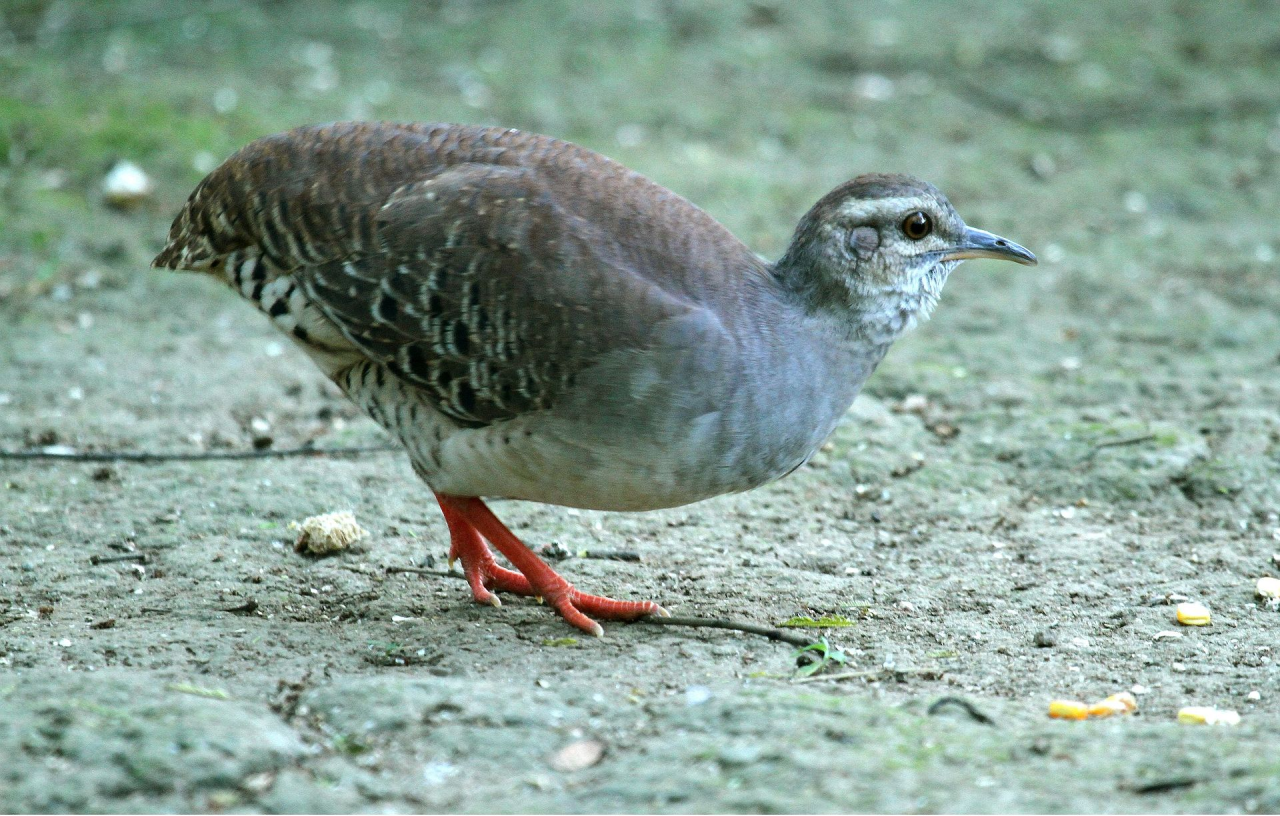
Pale-Browed Tinamou by Tony Castro, CC BY-SA 4.0
Modern species of Crypturellus are very loud birds, with males and females having different calls, and in some cases - like with the Slaty-Breasted Tinamou - the calls are so unique per bird that individuals can be recognized based on the calls. Other tinamous can be grouped together based on the similarity of their calls - the Undulated, Red-Legged, and Yellow-Legged Tinamou all make similar calls, while the Brown Tinamou, Small-Billed Tinamou, and Tataupa Tinamou all make similar calls. They like to eat fruit in their forested environment, but also will feed upon insects, which they often leap as high as 1 meter to grab. This genus mates by the male lowering his breast to the ground and then raising his neck vertically, making him look larger to impress females. The females will lay clutches of 2 eggs, with multiple females contributing to a nest until it reaches sizes of up to 16 eggs. Males that mated with all these females will then incubate and care for the young for 16 days. The chicks are very precocial and run around often like the chicks of rails, and gain maturity at 20 days.
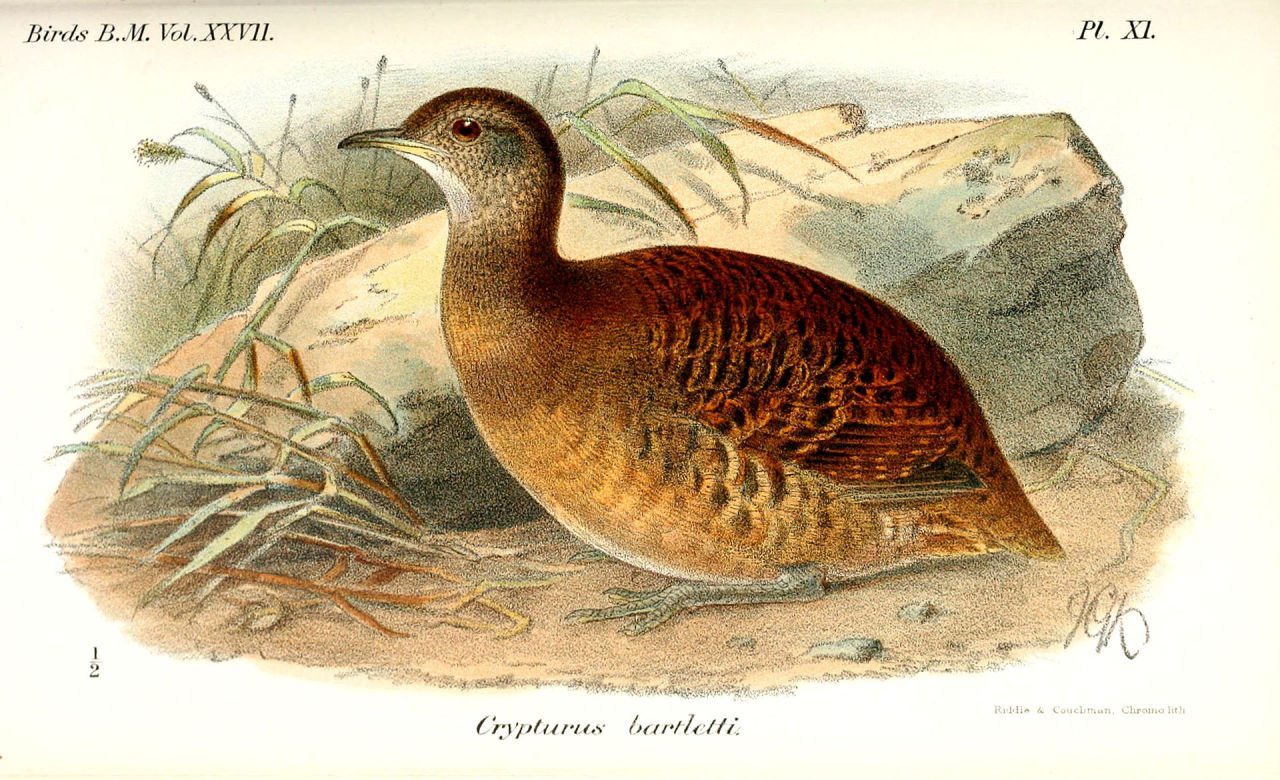
Bartlett’s Tinamou, from the British Museum, in the Public Domain
As stated, there are many species of tinamou, so time to go through them in alphabetical order (by species)! The Black-Capped Tinamou is from tropical lowlands in Peru and Bolivia, and has even extended to Brazil. It is black, brown, and grey, with its legs red. It behaves much like the other members of its genus, living in low lying bushes and feeding off of fruits, flowers, leaves, seeds, roots, and insects. Sadly, it is near-threatened. Bartlett’s Tinamou, above, is not endangered, and is found in subtropical and tropical forests in Brazil, Bolivia, Peru, and Ecuador, and its mostly brown with some black spots. It’s also about 27 centimeters long.

Berlepsch’s Tinamou by John Gerrard Keulemans, in the Public Domain
Berlepsch’s Tinamou is from Columbia and Ecuador, and though it has a very limited range in tropical habitats, it doesn’t appear to be threatened ecologically. It’s about 29.6 to 32 centimeters in length, with the females slightly heavier than the males. They’re usually a very dark brown, and though they can fly they rarely do, picking off fruit from low hanging branches.

Slaty-Breasted Tinamou by Exotic Ornithology, in the Public Domain
The Slaty-Breasted Tinamou is from Mexico and Central America, in lowland evergreen forests with thick undergrowth for it to hide in. It’s about 27 centimeters in length and very shy and difficult to spot, though it has a three note low call that’ll make for up to five hours at a time. The Rusty Tinamou, conversely, is mainly in tropical and swamp forests in South America, and though it isn’t threatened its habitat means it’s very difficult to spot this bird. The Barred Tinamou also lives in Colombia and Venezuela in tropical forests, and is smaller than other tinamous, only about 25 centimeters long, and also has yellowish feathers.

Cinereous Tinamou by Manuel Anastácio, CC BY-SA 2.5
The Cinereous Tinamou is from swamp and lowland forests in Brazil, Colombia, Venezuela, Suriname, Guyana, French Guiana, Ecuador, Peru, and Bolivia, mainly in the Amazon rainforest. They will sometimes venture out into the savanna and feed in coffee and cocoa plantations. They greatly supplement their fruity diet with insects such as ants and mole-crickets, and they eat a lot of seeds and berries in the winter. They don’t really make nests but just kind of lay their eggs in a giant pile of leaves on the floor. They also have a very loud whistle that they make at dawn and dusk.

Thicket Tinamou by Exotic Ornithology, in the Public Domain
The Thicket Tinamou is a reddish tinamou from Mexico, which isn’t endangered and very common. At 27 to 29 centimeters long, it’s fairly average in size. It makes a whoo-oo call and the tinamou are often found in pairs and families in various kinds of tropical and subtropical forests in the lowlands. It also lives in Costa Rica and lives very close to the United States. It’ll nest in raised roosts and eats a variety of fruits, seeds, and invertebrates.

Grey-Legged Tinamou by José Alvarez Alonso, CC BY 2.0
The Grey-Legged Tinamou is near threatened and from Colombia, Venezuela, and Brazil, though it may extend as far as Peru. It’s about 30 centimeters long, making it fairly large for this genus. They have a slightly varied diet and lives in drier lowland forests and dry scrubland, which it blends in with with its brown plumage.
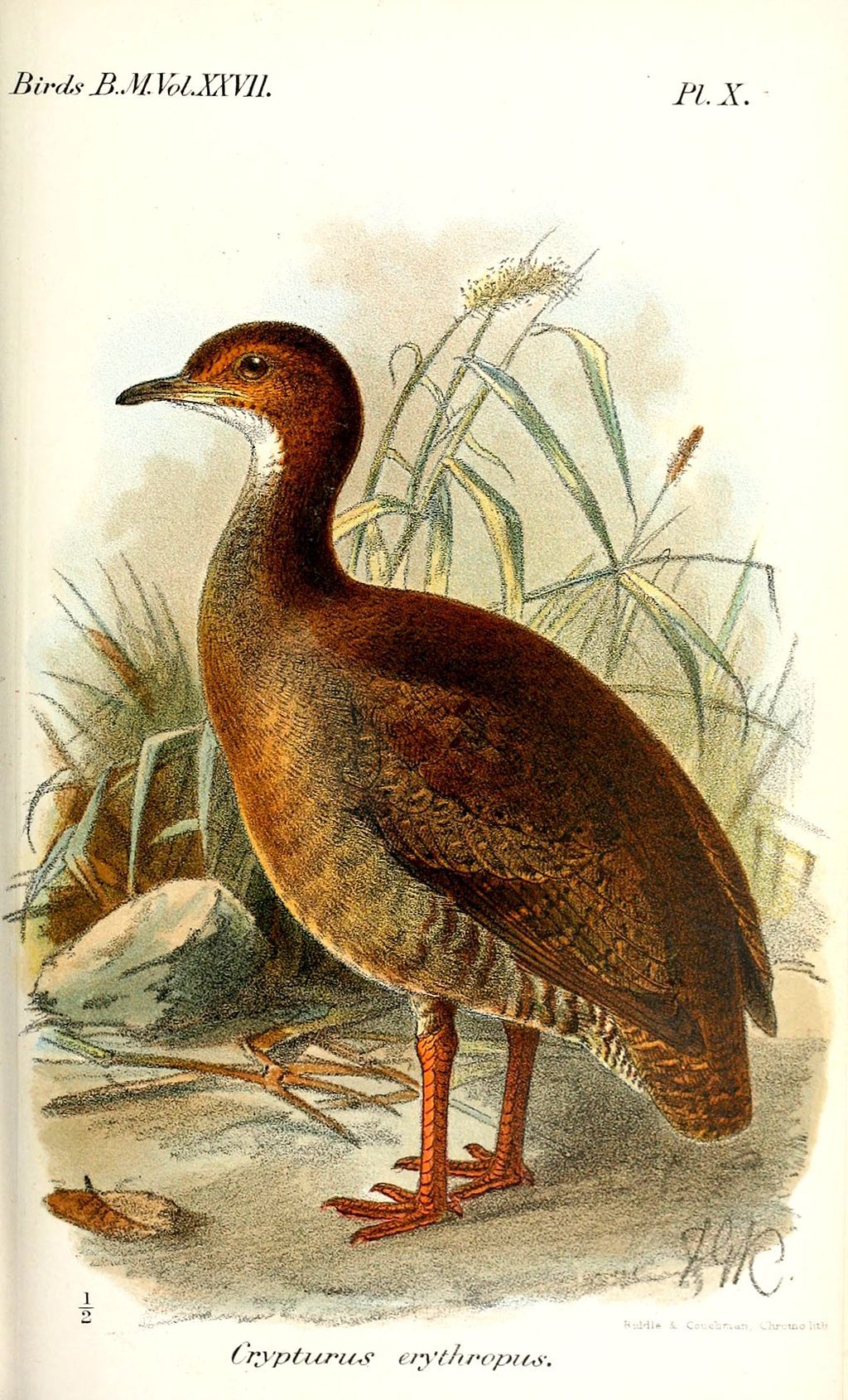
Red-Legged Tinamou by the British Museum, in the Public Domain
The Red-Legged Tinamou looks a lot like quail even though it’s not, it’s a tinamou. It can be anywhere between 27 and 32 centimeters in length, making it both small and big for this genus. It has a whistling call and it has pinkish eggs which I just find neat. They live in Guyana, Suriname, Colombia, Venezuela, and Brazil, and it might extend into French Guiana. It preferably lives in dry forests, though it does venture into wet forests, shrubland, and grassland. The Choco Tinamou (no image) is a very rare and vulnerable tinamou, quite small (about 25 to 26 centimeters in length), and it’s very dark as well. It has a sad sounding three note whistle. Being from tropical and subtropical moist forests, its habitats are being destructed by human activity and as such it is vulnerable to extinction. There are, however, efforts to conserve its habitat ongoing.

Yellow-Legged Tinamou by Marcos Massarioli, CCY BY 2.0
The Yellow-Legged Tinamou is near threatened and found in shrublands and woods in Brazil. It has grey-brown plumage and is about 28 to 31 centimeters long. It eats a lot of leaves, roots, and invertebrates in addition to fruit. Unfortunately, habitat destruction is to blame for its population loss.
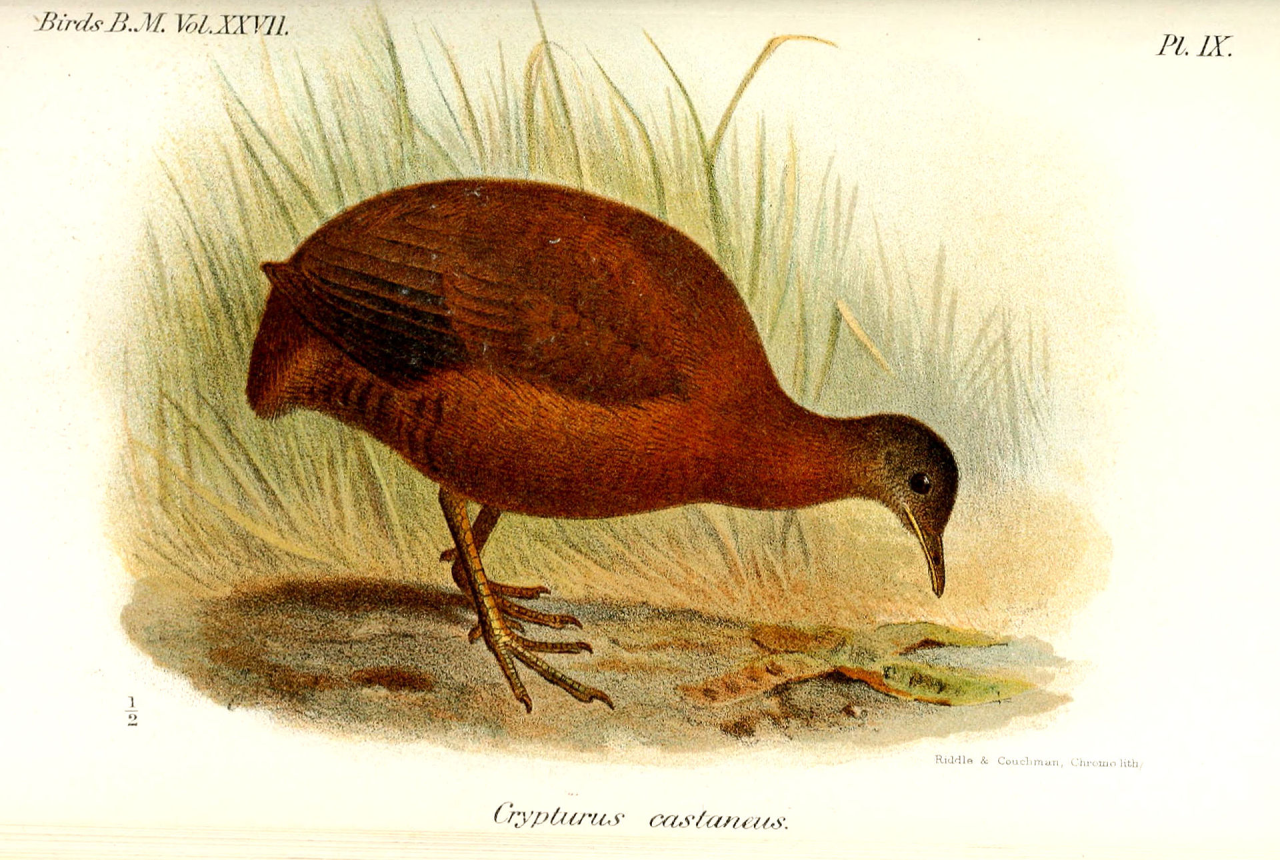
Brown Tinamou, by the British Museum, in the Public Domain
The Brown Tinamou lives in Venezuela, Colombia, Ecuador, Peru, Brazil, Argentina, Bolivia, Paraguay, and Uruguay, giving it one of the southernmost ranges of any living member of the genus. It lives in lowland and mountain forests, preferring high elevations. It is also very shy, making it hard to spot. It lives alone or in pairs, and is about 25 to 30 centimeters long on average.
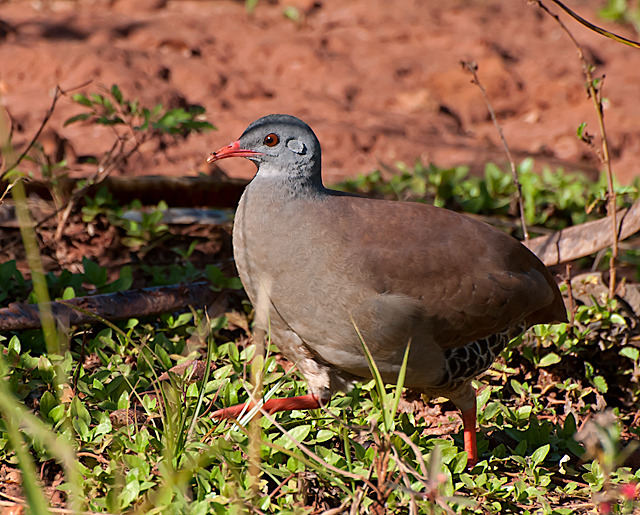
Small-Billed Tinamou by Dario Sanches, CC BY-SA 2.0
The Small-Billed Tinamou is known from Brazil, Peru, Bolivia, Paraguay, and Argentina, living in dry savanna and shrubland. It has a tiny, red bill and is about 22 centimeters in length, making it small in general - allowing it to hide easier in bushes and against the dry ground. The Tepui Tinamou is also a open-habitat-dwelling bird, known from only Venezeulan shrubland and mountain forests. Thus they live in higher altitudes. They’re about 27 centimters in length and eat lots of roots, leaves, seeds, flowers, and invertebrates in addition to fruit.
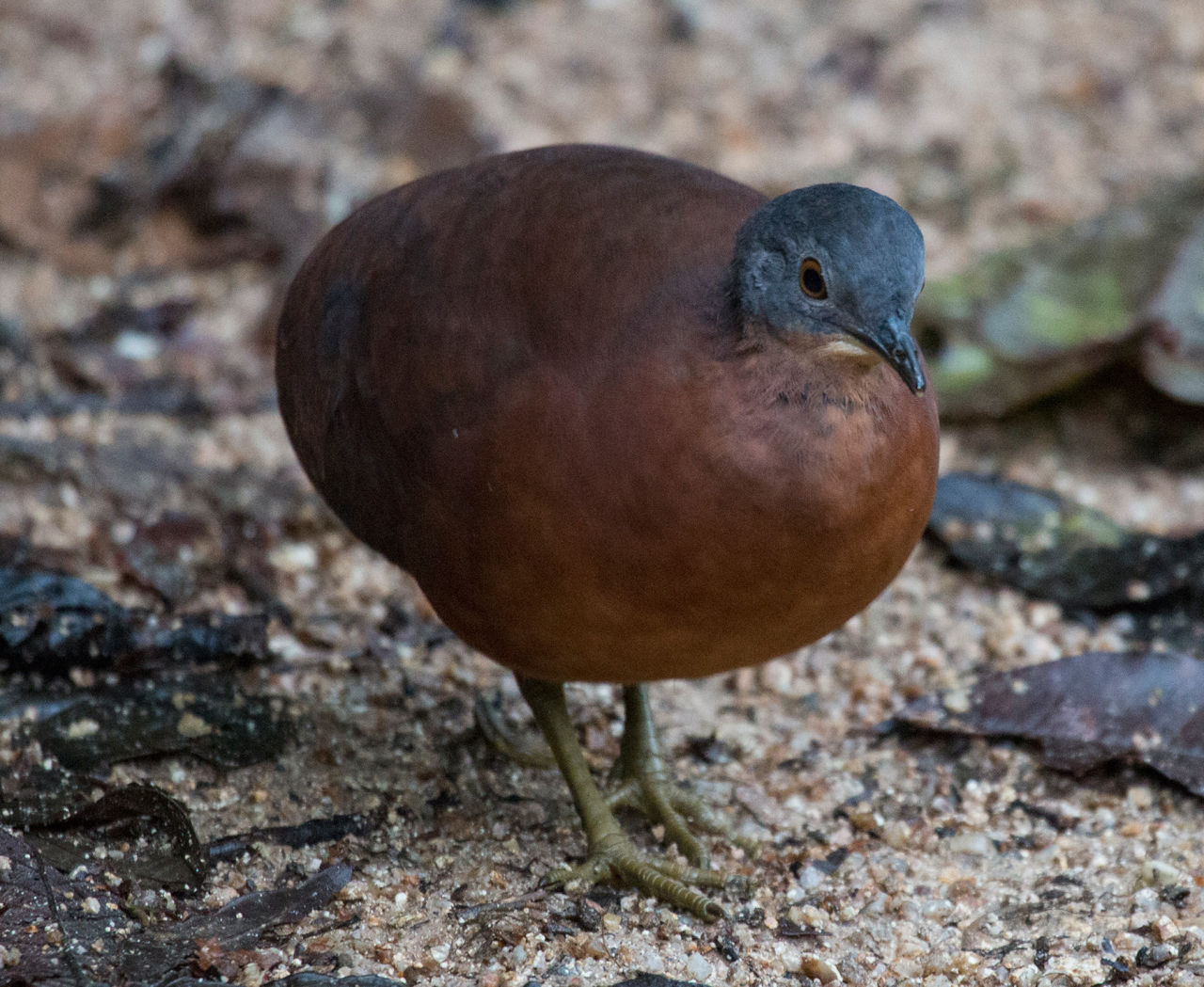
Little Tinamou, by Gary L. Clark, CC BY-SA 4.0
The Little Tinamou is about 22 centimeters long and very shy, making it quite adorable in my opinion. It’s rarely seen and lives in dark, dense forests across Central and South America. It’s also solitary, making spotting one even harder, and it’s very brown with a black head. It lives in lowland tropical forests and some shrubland, and they also will live in farmland successfully.

Brazilian Tinamou by Marcos Massarioli, CC BY 2.0
The Brazilian Tinamou lives in lowland forests that are primarily tropical and moist, and it lives in Bolivia, Brazil and Peru. They’re about 28 centimeters in length and are very common and not threatened ecologically.

Tataupa Tinamou, by Marcos Massarioli, CC BY-SA 3.0
The Tataupa Tinamou is about 25 centimeters in length and mainly dark greyish brown, with a bright red bill and reddish legs. They prefer dry forests and live in Brazil, Bolivia, Argentina, Paraguay, Peru, and even Ecuador.

Pale-Browed Tinamou by the Zoological Society of London, in the Public Domain
The Pale-Browed Tinamou is a near-threatened species from Peruvian and Ecuadorian arid forests. About 28 centimters long, it has striping along its feathers and pinkish to yellowish legs. Due to deforestation, its population is decreasing.

Undulated Tinamou by Marcos Massarioli, CC BY-SA 3.0
The Undulated Tinamou lives in wooded habitats of the Amazon Basin, and they’re also very shy, though they have a distinctive call that sounds like com-pra-pan, the Spanish phrase for “buy bread”. It’s about 28 to 30 centimeters in length and it is in general brownish grey and with black bars on its body and neck. It prefers drier habitats when possible.

Variegated Tinamou, by Luciana Costa, CC BY-SA 3.0
Our last species, the Veriegated Tinamou is from wet lowland forests with dense undergrowth across Colombia, Venezuela, French Guiana, Suriname, Guyana, Brazil, Peru, Ecuador, and Bolivia. It’s about 29.5 to 33 centimeters in length, making it fairly large, and it has striped feathers along its back. It’s throat is also white as are its butt feathers. They make five uniform notes for their call, sometimes trilling before descending in pitch. Luckily, it isn’t vulnerable for extinction.
Sources:
Chandler, R. M. 2012. A new species of Tinamou (Aves: Tinamiformes, Tinamidae) from the Early-Middle Miocene of Argentina. PalArch’s Journal of Vertebrate Palaeontology 9(2): 1 - 8.
https://en.wikipedia.org/wiki/Crypturellus
https://en.wikipedia.org/wiki/Black-capped_tinamou
https://en.wikipedia.org/wiki/Bartlett%27s_tinamou
https://en.wikipedia.org/wiki/Berlepsch%27s_tinamou
https://en.wikipedia.org/wiki/Slaty-breasted_tinamou
https://en.wikipedia.org/wiki/Rusty_tinamou
https://en.wikipedia.org/wiki/Barred_tinamou
https://en.wikipedia.org/wiki/Cinereous_tinamou
https://en.wikipedia.org/wiki/Thicket_tinamou
https://en.wikipedia.org/wiki/Grey-legged_tinamou
https://en.wikipedia.org/wiki/Red-legged_tinamou
https://en.wikipedia.org/wiki/Choco_tinamou
https://en.wikipedia.org/wiki/Yellow-legged_tinamou
https://en.wikipedia.org/wiki/Brown_tinamou
https://en.wikipedia.org/wiki/Small-billed_tinamou
https://en.wikipedia.org/wiki/Tepui_tinamou
https://en.wikipedia.org/wiki/Little_tinamou
https://en.wikipedia.org/wiki/Brazilian_tinamou
https://en.wikipedia.org/wiki/Tataupa_tinamou
https://en.wikipedia.org/wiki/Pale-browed_tinamou










